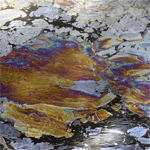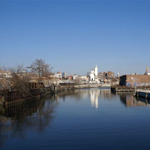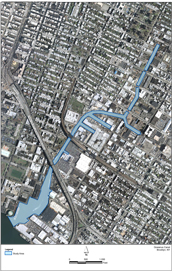Case Study - Brooklyn's Gowanus Canal
An urban waterway that identifies a community starts the process for cleanup

Locals call it "Lavender Lake" because of the opaque color of the water. Located in the borough of Brooklyn in New York City, the Gowanus Canal was originally designed as a shipping canal in 1869. Due to a lack of tidal water recirculation and inadequate design, coupled with a century and a half of pollution, the canal has developed into a highly anaerobic pool of contaminated water that extends one and a half miles into a mixed industrial and residential area. Discharge of industrial wastes, urban storm water, and municipal wastewater, and lack of circulation, have combined to create a highly polluted water body, now targeted for clean-up under the USEPA Superfund Program. Future re-development efforts are anticipated. The Gowanus Canal Community Development Corporation (GCCDC) was a "not-for-profit neighborhood preservation organization that was formed in 1978 to revitalize the communities of South Brooklyn, with particular emphasis on the area surrounding the Gowanus Canal. The Gowanus Canal is one of the most challenging, exciting and complex urban revitalization projects in the country" (emphasis added). "...GCCDC’s neighborhood efforts are focused achieving this revitalization through ...work in housing, environmental repair, commercial and social development." GCCDC had a goal of creating a centerpiece for understanding urban and industrial ecology.
Reprinted from the 2011 USEPA Region 2 Gowanus Canal Fact Sheet:
 Site Description. The Gowanus Canal is a 100-foot wide,1.8-mile long canal located in the New York City borough of Brooklyn, Kings County, New York. Connected to Gowanus Bay in Upper New York Bay, the canal borders several residential neighborhoods including Gowanus, Park Slope, Cobble Hill, Carroll Gardens, and Red Hook. The adjacent waterfront is primarily commercial and industrial, currently consisting of concrete plants, warehouses, and parking lots. There are five east-west bridge crossings over the canal, located at Union Street, Carroll Street, Third Street, Ninth Street, and Hamilton Avenue. The Gowanus Expressway and the IND Culver Line of the New York City Subway, an above ground section of the original Independent Subway System, pass overhead. The Gowanus Canal was built to allow access for industrial needs by bulkheading and dredging a tidal creek and wetland that had previously been fished for oysters.
Site Description. The Gowanus Canal is a 100-foot wide,1.8-mile long canal located in the New York City borough of Brooklyn, Kings County, New York. Connected to Gowanus Bay in Upper New York Bay, the canal borders several residential neighborhoods including Gowanus, Park Slope, Cobble Hill, Carroll Gardens, and Red Hook. The adjacent waterfront is primarily commercial and industrial, currently consisting of concrete plants, warehouses, and parking lots. There are five east-west bridge crossings over the canal, located at Union Street, Carroll Street, Third Street, Ninth Street, and Hamilton Avenue. The Gowanus Expressway and the IND Culver Line of the New York City Subway, an above ground section of the original Independent Subway System, pass overhead. The Gowanus Canal was built to allow access for industrial needs by bulkheading and dredging a tidal creek and wetland that had previously been fished for oysters.
After its completion in the 1860s, the canal quickly became one of the nation's busiest industrial waterways, home toheavy industry including gas works (i.e., manufactured gas plants), coal yards, cement makers, soap makers,tanneries, paint and ink factories, machine shops, chemical plants, and oil refineries. It was also the repository ofuntreated industrial wastes, raw sewage, and surface water runoff for decades, causing it to become one of New York's most polluted waterways. Although much of the industrial activity along the canal has stopped, high contaminant levels remain in the sediments. Despite the ongoing pollution problems, some city dwellers currently usethe Gowanus Canal for recreational purposes, such as canoeing and diving, while others catch fish for consumption.
The City built a "Flushing Tunnel" in 1911 to replace the stagnant water in the canal with fresh, oxygen-rich water that would improve water quality. The tunnel worked until the 1960s, when mechanical failure caused it to shut down and the canal became polluted and stagnant again. The city's Department of Environmental Protection subsequently restored the Flushing Tunnel. The tunnel operates 24 hours a day, seven days a week, bringing fresh water into the canal. The canal is part of the New York-New Jersey Estuary, which EPA has designated an Estuary of National Significance.
Threat and Contaminants. Numerous sampling events have shown the sediments in the Gowanus Canal to be contaminated with a variety of
pollutants, including polycyclic aromatic hydrocarbons (PAHs), volatile organic contaminants (VOCs), polychlorinated
biphenyls (PCBs), pesticides, and metals. PAH concentrations were found to be as high as 45,000 milligrams per
kilogram (4.5%) and the contamination was found to traverse the entire length of the canal. Many of the detected
contaminants are known carcinogens. The contaminated sediments pose an immediate risk to the fishery located just
downstream of the canal in Gowanus Bay. This fishery is well documented, and fish caught there are used as food.
Cleanup Approach. The site will be addressed in one stage—a long-term remedial phase focusing on the cleanup of the entire site. Response Action Status The Canal has been heavily contaminated throughout its existence. No environmental remediation has been undertaken to date. PRP-performed efforts are currently underway, under New York State authorities, at three former Manufactured Gas Plants (MGPs) located along the Gowanus Canal, which are believed to be sources of much of the Polyaromatic hydrocarbon (PAH) contamination in the canal--the former Fulton MGP site; Former Citizens Gas Works MGP site (a.k.a. Carroll Gardens/Public Place); and former Metropolitan Gas Light Company MGP site. National Grid is the PRP for the MGP sites. In April 2009, EPA proposed to put the Gowanus Canal on the National Priorities List (NPL). While the community and many elected officials supported the listing, the City of New York and some development interests did not. New York City proposed an alternate approach which would have depended heavily on the assumption of long-term Congressional funding to Corps of Engineers (COE). After consulting extensively with the many stakeholders who expressed interest in the future of the Gowanus Canal and the surrounding area, EPA determined that a Superfund designation was the best path to a clean up of this heavily contaminated and long neglected urban waterway. The site was listed on the NPL on March 4, 2010 (USEPA Region 2, 2011)
***
The Gowanus Canal
is an 18-minute short subject film about the Gowanus Canal by Anand Kamalakar. A winner of the Brooklyn Film Festival, this short subject documentary explores the Gowanus Canal and its place in the surrounding community. -GM

